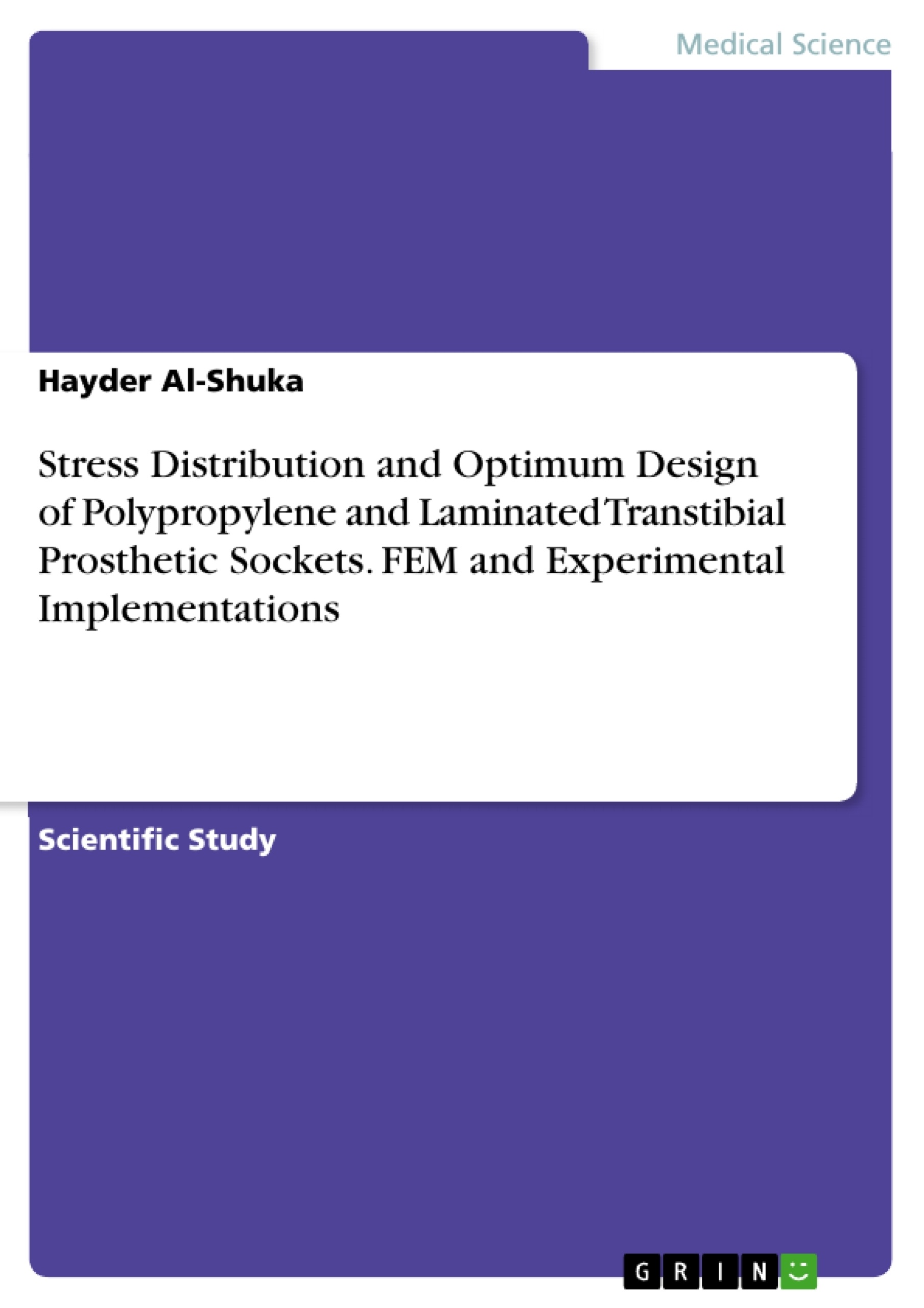This study presents analyses for below knee prosthetic socket of a human. Socket stress distribution is performed on three types of socket, polypropylene (5mm), polypropylene (3mm) and a standard laminate (3mm) sockets to determine the stresses path through the prosthetic socket during the gait cycle. It is found that heel strike phase is the critical phase. The stresses increase at the socket base while the maximum deflection is maximum at the patellar region of the socket. This work is achieved by finite element program, ANSYS.
The development of design specifications of a below the knee prosthetic socket is presented in this study for successful ambulation and comfort. Seven different design models are created by changing the socket wall thickness and the material. Polypropylene socket gives the best results with regard to the allowable deflection for the regions of the pressure relief areas of the stump.
The effect of varying the modulus of elasticity on the polypropylene socket is considered in this study. Three models are analyzed with different tensile creep moduli during different periods. It is found that the polypropylene socket will enlarge in size with time.
An experimental study is conducted to compare the strength of five prosthetic sockets made of different materials. Compression, three-point flexural and tensile tests are implemented by the Testometric machine. The laminate sockets have larger compressive stiffness than polypropylene while polypropylene has larger flexural stiffness than the tested laminates except for socket No.5.
Inhaltsverzeichnis (Table of Contents)
- Chapter 1: Introduction and Literature Survey
- 1.1. General
- 1.2. The Effect of Stiffness
- 1.3. Literature Review
- 1.4. Concluding Remarks
- 1.5. Objectives of Work
- Chapter 2: Theoretical Analysis
- 2.1. Gait cycle
- 2.2. Ground Reaction Forces (GRFs)
- 2.3. Socket Stress Distribution
- 2.3.1. Introduction
- 2.3.2. Socket Stress Distribution Using ANSYS Package
- 2.4. Design Specifications of below the Knee Prosthetic Socket
- 2.4.1. Introduction
- 2.4.2. Finite Element Model
- 2.4.3. Alternate Designs
- 2.5. The Effect of Varying Modulus of Elasticity on Polypropylene Socket
- 2.5.1 Finite Element Model
- 2.5.2 Alternate Analyses
- Chapter 3: Experimental work
- 3.1. Introduction
- 3.2 Prosthetic Socket Manufacturing
- 3.2.1 Polypropylene Socket Manufacturing
- 3.2.2. Laminated Socket Manufacturing
- 3.3. The Tested Sockets
- 3.4. Testing the Samples
- 3.4.1 Testometric Machine
- 3.4.2 Compression Test
- 3.4.3 Flexural Test
- 3.4.4 Tensile Test
- Chapter 4: Results and discussions
- 4.1 The Results of Socket Stress Distribution
- 4.2. The Results of Design Specifications of below the Knee Prosthetic Socket
- 4-3. The Results of the Effect of Varying Modulus of Elasticity on PP Socket
- 4.4. Experimental Work Results
- 4.4.1 Compression Test Results
- 3.3.2 Flexural Test Results
- 4.3.3. Tensile Test Results
Zielsetzung und Themenschwerpunkte (Objectives and Key Themes)
This study focuses on analyzing the stress distribution and optimizing the design of transtibial prosthetic sockets using finite element analysis (FEA) and experimental testing. The goal is to improve the comfort, functionality, and durability of prosthetic sockets for below-knee amputees.
- Stress distribution within prosthetic sockets during the gait cycle
- Development of design specifications for transtibial prosthetic sockets
- Influence of material properties on socket performance
- Experimental validation of socket strength and stiffness
- Comparison of different socket materials and designs
Zusammenfassung der Kapitel (Chapter Summaries)
Chapter 1 provides an introduction and literature survey on transtibial prosthetic sockets, highlighting the significance of understanding human locomotion and the various factors affecting prosthetic socket design and functionality. Chapter 2 delves into the theoretical analysis of socket stress distribution, examining the gait cycle, ground reaction forces, and the application of FEA using ANSYS software. Chapter 3 outlines the experimental work conducted, including the manufacturing process for different socket types (polypropylene and laminate) and the testing methods employed using a Testometric machine for compression, flexural, and tensile tests. Chapter 4 presents and discusses the results obtained from both the FEA and experimental testing, analyzing the stress distribution patterns, the impact of material properties on socket performance, and the comparison of different designs.
Schlüsselwörter (Keywords)
The key concepts and terms explored in this study include transtibial prosthetic sockets, finite element analysis (FEA), ANSYS software, gait cycle, ground reaction forces, stress distribution, material properties, polypropylene, laminate, compression test, flexural test, tensile test, Testometric machine, design optimization, and biomechanics.
- Citar trabajo
- Dr. Hayder Al-Shuka (Autor), 2017, Stress Distribution and Optimum Design of Polypropylene and Laminated Transtibial Prosthetic Sockets. FEM and Experimental Implementations, Múnich, GRIN Verlag, https://www.grin.com/document/385910




